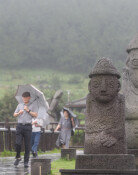Power of storytelling in cultural heritage discovered on 'Monclar's Path'
Power of storytelling in cultural heritage discovered on 'Monclar's Path'
Posted June. 28, 2024 07:54,
Updated June. 28, 2024 07:54
"To my beloved son Roland. I came here to make sure that young Korean children like you won't have to wander on the streets, in the dirt, or in the snow."
This is an excerpt from a letter written by French General Ralph Monclar (1892-1964), who fought in the Korean War, to his 11-month-old son on December 23, 1950. That winter, amidst the harsh weather that made even firing a gun difficult due to frozen fingers, Monclar was enduring the fierce onslaught of the Chinese forces. In February of the following year, the French troops and a regiment of American soldiers under Monclar’s command encountered three Chinese divisions advancing south of the 38th parallel at Jipyeong-ri in Yangpyeong County, Gyeonggi Province. Outnumbered five to one, they abandoned strategically advantageous high ground to form a circular defense on flat terrain. Under Monclar’s command, a seasoned veteran of both World Wars, they engaged in hand-to-hand combat with bayonets, ultimately securing the first victory against the Chinese forces in the Korean War. This battle is legendary in the annals of the Korean War as the "Battle of Jipyeong-ri."
Monclar had voluntarily demoted himself from Lieutenant General to Lieutenant Colonel to participate in the Korean War, following the French government's policy of sending only battalion-sized units. He explained his motivation for doing so: "I wanted to pass on to my soon-to-be-born child the pride of having been the first French member of the UN forces to participate."
Recently, KT subsidiary Storywiz and Jipyeong-ri Cultural Content Co. announced plans to adapt General Monclar's story from the Battle of Jipyeong-ri into webtoons and web novels. Last year, the Ministry of Patriots and Veterans Affairs dedicated a 3,421-meter-long bicycle path along the Namhan River in the Jipyeong-ri area, named "Monclar's Path," symbolizing the 3,421 French soldiers who fought there. Travelers enjoying the scenic ride along the Namhan River can reflect on the dedication of the allied forces to freedom as they pass through this segment.
The Jipyeong-ri case is a compelling example of the growing trend among local governments to develop regional cultural heritage as tourist resources. It's not just about creating paths; it's about preserving and promoting these historical sites through storytelling. Erecting plaques to commemorate famous people or places is a start, but it's the stories behind these sites that truly bring them to life. For instance, the discovery of lacquered armor at Gongju's Gongsanseong Fortress can evoke the image of King Uija's final stand against the Silla forces, reminding us of the importance of preserving our past.
The significance of relics and heritage sites can be greatly enhanced by the storytelling associated with them. A prime example is the "Ancient Pool" in Hierapolis, Turkey, a Roman-era resort city. The statues and columns dating back 2,500 years lining the bottom of this hot spring pool are not mere decorations. Tourists can walk on them, physically connecting with the remnants of an ancient civilization that collapsed in the great earthquake of 692.
Similarly, Gyeongju's status as a representative historical city of Korea owes much to the storytelling of Silla tomb excavations. The large stone chamber tombs, including the Hwangnamdaechong, excavated under President Park Chung-hee’s leadership in the 1970s, symbolically showcased the splendor of Silla's golden culture. Just as President Park personally drafted the "Gyeongju Tourism Comprehensive Development Plan" in 1971, encompassing excavation sites, it is time to consider policies that incorporate storytelling into cultural heritage seriously.







